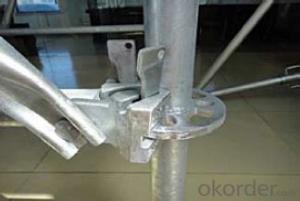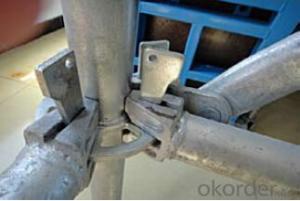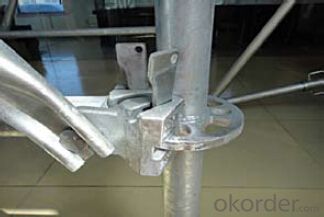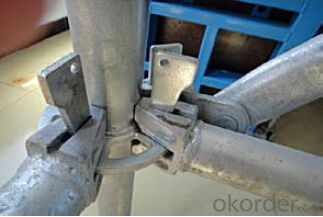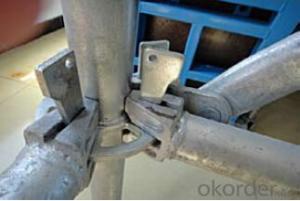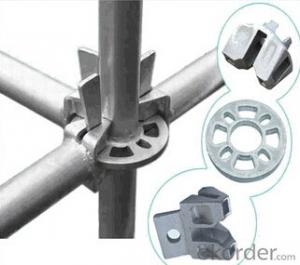Ring Lock Scaffolding Accessories for scaffolding systems
- Loading Port:
- Tianjin
- Payment Terms:
- TT OR LC
- Min Order Qty:
- 50 m²
- Supply Capability:
- 1000 m²/month
OKorder Service Pledge
Quality Product, Order Online Tracking, Timely Delivery
OKorder Financial Service
Credit Rating, Credit Services, Credit Purchasing
You Might Also Like
Ring-lock Scaffolding
A support system for construction, ownsadvantages of both cup-lock scaffolding andshoring tower.
It is in the development direction of new typescaffolding.
It is widely used in buildings, bridges, tunnels etc..
Characteristics:
◆ Easy to storage and transportation
◆ High degree of standardization
◆ Easy and quick erection
◆ Excellent stability and bearing capacity
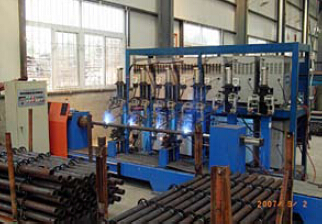

- Q: How does steel formwork affect the overall project timeline?
- Steel formwork can have a positive impact on the overall project timeline. Its durability and reusability allow for faster and more efficient construction processes, reducing the time required for formwork installation and removal. Additionally, steel formwork often requires less maintenance and repairs compared to traditional wooden formwork, minimizing potential delays caused by formwork issues.
- Q: Can steel formwork be used in bridge construction projects?
- Yes, steel formwork can be used in bridge construction projects. Steel formwork offers several advantages such as durability, flexibility, and reusability, making it a suitable choice for constructing bridges. It provides the necessary support and structure during the concrete pouring process, ensuring the bridge's strength and stability. Additionally, steel formwork allows for faster construction and can be customized to meet specific design requirements, making it a preferred option for many bridge construction projects.
- Q: Can steel formwork be used for both reinforced and unreinforced concrete structures?
- Both reinforced and unreinforced concrete structures can utilize steel formwork. This versatile and durable option can be easily assembled and disassembled for a variety of construction projects. It provides a sturdy and inflexible framework for pouring concrete, ensuring that the concrete remains in place until it cures and gains sufficient strength. Steel formwork is particularly advantageous for reinforced concrete structures as it can withstand the additional weight and pressure of reinforcement bars and mesh. The formwork can be designed to accommodate the specific reinforcement requirements of the structure, enabling proper placement and alignment of the reinforcement elements. Similarly, steel formwork can be employed for unreinforced concrete structures. In this scenario, the formwork acts as a temporary mold that holds the concrete in the desired shape until it solidifies. The steel formwork aids in achieving precise dimensions and finishes, guaranteeing that the final concrete structure meets the desired specifications. To summarize, steel formwork is a suitable choice for both reinforced and unreinforced concrete structures. Its strength, durability, and flexibility make it a preferred option for a wide range of construction projects, providing a reliable and efficient solution for creating high-quality concrete structures.
- Q: What are the different types of edge protections available for steel formwork?
- There are several types of edge protections available for steel formwork, including steel edge angles, timber edge fillets, plastic edge profiles, and rubber edge guards. These edge protections are used to ensure the safety of workers by preventing them from accidentally stepping off the edge of the formwork.
- Q: Can steel formwork be used in curved or irregular structures?
- Curved or irregular structures can indeed make use of steel formwork. This type of formwork grants great flexibility and can be effortlessly modified to generate different shapes and curves. It presents the benefit of withstanding substantial pressure, enabling the efficient and accurate construction of curved or irregular structures. Steel formwork is especially appropriate for intricate architectural designs and structures necessitating distinctive shapes, like curved walls, columns, and beams. Furthermore, the durability and strength of steel render it a dependable option for such applications, guaranteeing the stability and longevity of the structure.
- Q: Can steel formwork be used for both straight and curved concrete walls?
- Yes, steel formwork can be used for both straight and curved concrete walls. Steel formwork is versatile and can be easily bent and adjusted to create curved walls of various shapes and sizes. It provides strong support and stability, allowing for the construction of both straight and curved walls with precision and accuracy. Additionally, steel formwork is durable and reusable, making it a cost-effective option for projects that require both straight and curved concrete walls.
- Q: Are there any specific considerations for using steel formwork in areas with limited space?
- Yes, there are several specific considerations for using steel formwork in areas with limited space. Firstly, the dimensions of the steel formwork system should be carefully chosen to ensure that it can fit into the available space. This includes considering the height, width, and depth of the formwork components, as well as any necessary clearances for movement and installation. Secondly, the assembly and disassembly of the steel formwork system should be carefully planned to minimize the space required. This may involve using smaller formwork panels or modular systems that can be easily transported and maneuvered in tight spaces. Additionally, the sequencing of formwork removal should be considered to ensure that there is enough space for workers and equipment to safely access the area. Thirdly, the storage of steel formwork components when not in use should be taken into account. In areas with limited space, it may be necessary to stack the formwork panels vertically or utilize compact storage solutions to maximize space efficiency. Lastly, the accessibility of the construction site should be considered. In areas with limited space, it may be challenging to transport and deliver the steel formwork components. It is important to evaluate the availability of access roads, parking areas, and equipment staging areas to ensure that the steel formwork can be safely and efficiently delivered to the construction site. Overall, using steel formwork in areas with limited space requires careful planning and consideration of the dimensions, assembly, disassembly, storage, and site accessibility. By addressing these specific considerations, it is possible to effectively utilize steel formwork systems in tight spaces while ensuring the safety and efficiency of the construction process.
- Q: Can steel formwork be used for projects with complex geometries?
- Indeed, projects with intricate geometries can make use of steel formwork. Thanks to its high strength and durability, steel formwork proves to be suitable for managing complex shapes and intricate designs. The fabrication and customization of steel formwork can be easily achieved to meet the project's specific requirements, enabling the creation of complex geometries while maintaining structural integrity. Furthermore, steel formwork guarantees exceptional dimensional stability, ensuring the precise and accurate construction of complex shapes. Given its versatility and flexibility, steel formwork emerges as the preferred option for projects involving intricate and complex geometries.
- Q: How does steel formwork contribute to faster construction?
- There are several ways in which steel formwork speeds up construction. Firstly, steel formwork is exceptionally durable and can endure multiple uses. This means it can be reused on various construction projects, reducing the need to constantly manufacture new formwork. This not only saves time but also cuts costs associated with buying new materials for each project. Moreover, steel formwork is quick and simple to assemble and disassemble. The modular nature of steel formwork allows for efficient installation and removal, enabling construction teams to complete projects at a faster pace. This is particularly advantageous for projects with tight schedules or where speed is crucial. Furthermore, steel formwork provides a smooth and consistent surface finish, eliminating the need for additional plastering or finishing work. This saves time and effort during the construction process, as there is no need to wait for plaster or other finishing materials to dry before moving on to the next stage. Additionally, steel formwork offers greater design flexibility. Steel can be easily fabricated into various shapes and sizes, allowing for the construction of complex structures. This versatility eliminates the need for expensive and time-consuming custom formwork solutions, as steel formwork can be adapted to meet the specific requirements of each project. Lastly, steel formwork is renowned for its excellent strength and stability. It can withstand heavy loads and adverse weather conditions, ensuring the safety and stability of the construction site. This reduces the risk of delays due to structural issues or the need for additional reinforcements, allowing the construction process to progress smoothly and efficiently. Overall, the use of steel formwork in construction projects speeds up construction by providing durability, easy assembly and disassembly, a smooth surface finish, design flexibility, and enhanced strength and stability. These factors combined help to streamline the construction process and reduce the overall project timeline.
- Q: Can steel formwork be customized to meet specific project requirements?
- Yes, steel formwork can be customized to meet specific project requirements. Steel formwork is a versatile and flexible construction material that can be easily modified and adjusted to fit different shapes, sizes, and dimensions. It can be cut, welded, and reshaped to match the specific requirements of a project. Additionally, steel formwork allows for the creation of complex and intricate structures, making it suitable for a wide range of construction projects. The customization of steel formwork enables builders and contractors to achieve precise and accurate results, ensuring that the final structure meets the desired specifications and design requirements.
Send your message to us
Ring Lock Scaffolding Accessories for scaffolding systems
- Loading Port:
- Tianjin
- Payment Terms:
- TT OR LC
- Min Order Qty:
- 50 m²
- Supply Capability:
- 1000 m²/month
OKorder Service Pledge
Quality Product, Order Online Tracking, Timely Delivery
OKorder Financial Service
Credit Rating, Credit Services, Credit Purchasing
Similar products
Hot products
Hot Searches
Related keywords
